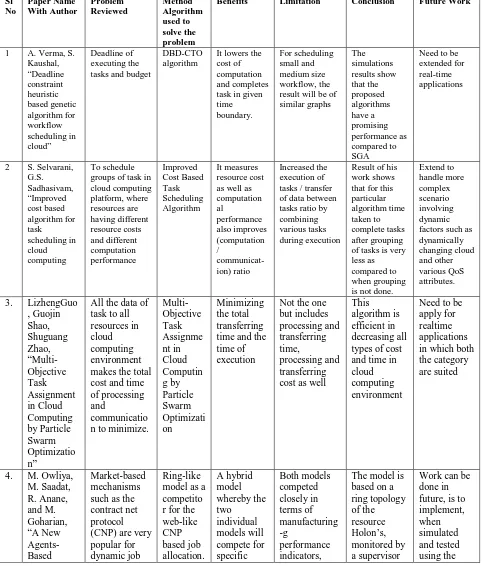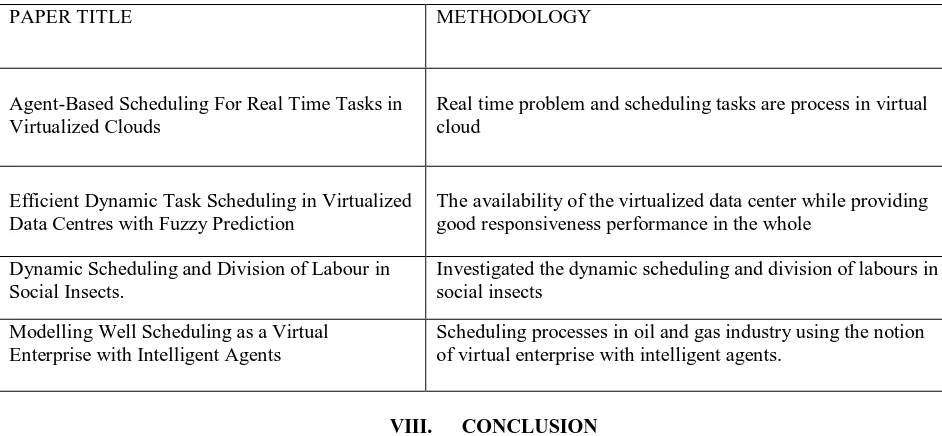Angel-Agent Based Scheduling for Real Time
Tasks in Virtualized Clouds
Deepa Nelgi 1, Sunil H Vernekar 2
U.G. Student, Dept. of Computer Application, KLES’s BCA, P.C.Jabin Science College, Hubli, India 1
Associate Professor, Dept. of Computer Application, KLES’s BCA, P.C.Jabin Science College, Hubli, India 2
ABSTRACT: The success of cloud computing makes an increasing number of real-time applications such as signal processing and weather forecasting run in the cloud. Meanwhile, scheduling for real-time tasks is playing an essential role for a cloud provider to maintain its quality of service and enhance the system’s performance, for a given set of jobs the general scheduling problem asks for an order according to which the jobs are to be executed such that various constraints are satisfied. Typically, a job is characterized by its execution time, ready time, deadline and resource requirements. Specifically, the execution of a job cannot begin until the execution of all its predecessors is completed. In this paper, we devise a novel agent-based scheduling mechanism in cloud computing environment to allocate real-time tasks and dynamically provision resources. On the basis of the bidirectional announcement-bidding mechanism, we propose an agent-based dynamic scheduling algorithm named ANGEL for real-time, independent and a periodic tasks in clouds. Extensive experiments are conducted on Cloud Sim platform by injecting random synthetic workloads and the workloads from the last version of the Google cloud trace logs to evaluate the performance of our ANGEL. The experimental results indicate that ANGEL can efficiently solve the real-time task scheduling problem in virtualized clouds.
KEYWORDS: Agent-based scheduling, real-time, bidirectional announcement-bidding mechanism, virtualized cloud.
I. INTRODUCTION CLOUD COMPUTING
Cloud computing is one of the latest emerging technique. Cloud computing is of computing services over the internet. Nowadays cloud environment is used in most of the business organizations and educational institutions. The ultimate definition for the cloud computing has been developed by NIST was the cloud computing is a model for allowing convenient, on demand network access to a shared huge number of configurable resources such as networks, servers, storage, applications, and services that can be quickly provisioned and released with minimal management effort or service supplier communication. This cloud model encourages availability and is group of five essential features, three service models, and four deployment models. Cloud computing provides high quality and low-cost information services. It is a pay-peruse model in which guarantees are offered by the cloud service providers.
II. CHARACTERISTICS OF CLOUD COMPUTING
The following are the characteristics, in which the cloud computing include, 1. On-demand self service
2. Broad network admission 3. Resource sharing
4. Rapid elasticity and measured facilities
3.Infrastructure as a service (IaaS) – sharing of hardware resources for executing service.
IV. SCHEDULING
In cloud computing, scheduling is the most prominent activity. Scheduling is one of the tasks performed to get maximum profit and to increase the efficiency of the work load of cloud computing. The main focus about the scheduling algorithm is to employ the resources properly while managing the load between the resources to get the minimum performance time. There are numerous algorithms for scheduling in cloud computing. To gain high performance is the main advantage of scheduling. Examples of scheduling algorithms are Round-Robin, Min-Min, FCFS, Max-Min and Meta-heuristic algorithms etc.
V. TASK SCHEDULING
The essential concept of cloud computing system is task scheduling. This algorithm aims at reducing the make span of jobs with lowest resources capably. Scheduling algorithms depends on the type of task to be scheduled. The scheduling algorithm gives better executing efficiency and it maintains the load balancing of systems. The cloud efficiency is depends on the task scheduling algorithm. There are different types of task scheduling. Some are cloud service scheduling, user level scheduling, static and dynamic scheduling, heuristic scheduling, real time scheduling, work flow scheduling etc.
VI. VIRTUALIZATION
Virtualization is a technique that creates abstract layer of system resources and it hides the complexity of hardware and software environment. Virtualization is usually implemented with hypervisor technology, with the help of virtualization we can take one server to be appearing as many. The common forms of virtualization are desktop virtualization, server virtualization, virtual networks, and virtual storage. Hypervisor or virtual machine monitor (VMM) is software which runs on virtual machine. A hypervisor that runs one or more virtual machines is called as host machine. This machine can be a server or a computer. In this each virtual machine is called as guest machine. Also the important paybacks on virtualization contain sharing of resources, encapsulation, isolation, hardware independence, portability.
VII. LITERATURE SUMMARY
1. Static scheduling algorithms assignments of tasks and the time at which the tasks start to execute are determined a priori. They are usually developed for periodic tasks. Whereas the arrival time of a periodic task is not known a priori and with timing requirements, the tasks must be scheduled by dynamic scheduling strategies.
Table 1. Comparison Table Sl No Paper Name With Author Problem Reviewed Method Algorithm used to solve the problem
Benefits Limitation Conclusion Future Work
1 A. Verma, S. Kaushal, “Deadline constraint heuristic based genetic algorithm for workflow scheduling in cloud” Deadline of executing the tasks and budget
DBD-CTO algorithm
It lowers the cost of computation and completes task in given time boundary. For scheduling small and medium size workflow, the result will be of similar graphs The simulations results show that the proposed algorithms have a promising performance as compared to SGA
Need to be extended for real-time applications
2 S. Selvarani, G.S. Sadhasivam, “Improved cost based algorithm for task scheduling in cloud computing To schedule groups of task in cloud computing platform, where resources are having different resource costs and different computation performance Improved Cost Based Task Scheduling Algorithm It measures resource cost as well as computation al performance also improves (computation / communicat-ion) ratio Increased the execution of tasks / transfer of data between tasks ratio by combining various tasks during execution
Result of his work shows that for this particular algorithm time taken to complete tasks after grouping of tasks is very less as compared to when grouping is not done.
Extend to handle more complex scenario involving dynamic factors such as dynamically changing cloud and other various QoS attributes.
3. LizhengGuo , Guojin Shao, Shuguang Zhao, “Multi-Objective Task Assignment in Cloud Computing by Particle Swarm Optimizatio n”
All the data of task to all resources in cloud computing environment makes the total cost and time of processing and
communicatio n to minimize.
Multi-Objective Task Assignme nt in Cloud Computin g by Particle Swarm Optimizati on Minimizing the total transferring time and the time of execution
Not the one but includes processing and transferring time, processing and transferring cost as well
This algorithm is efficient in decreasing all types of cost and time in cloud computing environment
Need to be apply for realtime applications in which both the category are suited
4. M. Owliya, M. Saadat, R. Anane, and M. Goharian, Market-based mechanisms such as the contract net protocol
Ring-like model as a competito r for the web-like A hybrid model whereby the two individual Both models competed closely in terms of manufacturing
The model is based on a ring topology of the resource
Model for Dynamic Job Allocation in
Manufacturi ng Shop floors
allocation in distributed manufacturing control and scheduling. The CNP can be deployed with different configurations of the system elements.
performance indicators in any
particular manufacturi ng scenario.
including time and cost,
Holon data from a real turbine manufacturin g plant.
5. P. Graubner, M.Schmidt, and B.Freisleben , “Energy-efficient management of virtual machines in Eucalyptus
An approach for improving the energy efficiency of infrastructure-as-a service clouds is presented
Map Reduce Applicatio n(relocati on algorithm)
Energy costs of live migrations including their pre- and post processing phases are taken into account. VM live migrations has been added to the EUCALYP TUS Open-source CC system.
It is not possible to save any energy, the presented approach does not consume more energy than the original version of EUCALYPTU S
The results have
indicated that energy savings of up to 16 percent can be achieved in a productive EUCALYPT US
environment
With this overall comparison the selected concepts are discussed in the future implementation task, they are
Table 2 Comparison Table of Methodology
PAPER TITLE METHODOLOGY
Agent-Based Scheduling For Real Time Tasks in Virtualized Clouds
Real time problem and scheduling tasks are process in virtual cloud
Efficient Dynamic Task Scheduling in Virtualized Data Centres with Fuzzy Prediction
The availability of the virtualized data center while providing good responsiveness performance in the whole
Dynamic Scheduling and Division of Labour in Social Insects.
Investigated the dynamic scheduling and division of labours in social insects
Modelling Well Scheduling as a Virtual Enterprise with Intelligent Agents
Scheduling processes in oil and gas industry using the notion of virtual enterprise with intelligent agents.
VIII. CONCLUSION
The scheduling is one of the most important problems in cloud computing; always there is a chance of alteration of previously completed work in this particular field. During scheduling so many authors has considered various techniques and applied many constraints but as the cloud computing is too vast that they had not been able to capture all features at the same time but they mentioned some facts that there is a chance of modification of algorithms and which part has to be modified. So finally my work in future will be focused by giving importance for to improving the scheduling process.
REFERENCES
[1] VermaS. Kaushal, “Deadline constraint heuristic based genetic algorithm for workflow scheduling in cloud” Forthcoming article in international journal of grid and utility computing.
[2] ANGEL: Agent-Based Scheduling For Real-Time Tasks in Virtualized Clouds Xiaomin Zhu, Member, IEEE, Chao Chen, Laurence T. Yang, Senior Member, IEEE, and Yang Xiang, Senior IEEE Transactions on Computers, VOL.NO.2015.
[3] Selvarani.G.S. Sadhasivam, “Improved cost-based algorithm for task scheduling in cloud computing” computational intelligence and computing research, pp.1-5, 2010.
[4] S. Pandey, L. Wu, S. Mayura Guru, R. Buyya, “A particle swarm optimization-based heuristic for scheduling workflow applications in cloud computing environments,” 24th IEEE international conference on advanced information networking and applications, PP 400-407, 2010. [5] LizhengGuo, Guojin Shao, Shuguang Zhao, “Multi-Objective Task Assignment in Cloud Computing by Particle Swarm Optimization”,
978-1-61284-683-5/12/$31.00 2012 IEEE
[6] Verma.S.Kaushal, “Bi-Criteria Priority Based Particle Swarm Optimization Workflow Scheduling algorithm for cloud” Proceedings of 2014 RAECS UIET Panjab University Chandigarh, 06-08 March, 2014.
[7] Chenhong Zhao, Shanshan Zhang, Qingfeng Liu, JianXie, Jicheng Hu, “Independent tasks scheduling based on Genetic Algorithm in Cloud
Computing”, 978-1-4244-3693-4/09/$25.00 2009 IEEE. [8] GAN Guo-ning, HUANG Ting-lei, GAO Shuai, “Genetic Simulated Annealing Algorithm for task scheduling based on Cloud Computing
Environment”, 978-1-4244-6837-9/10/$26.00 2010 IEEE.
[9] X. Kong, C. Lin, Y. Jiang, W. Yan, and X. Chu, “Efficient Dynamic Task Scheduling in Virtualized Data Centers with Fuzzy Prediction,” J. Network and Computer Applications, vol. 34, no. 4, pp. 1068-1077, 2011.
[12] International Journal of Computer Trends and Technology (IJCTT) – volume 9 number 7 - Mar 2014 ISSN: 2231-2803 http://www.ijcttjournal.orgPage379”Analysis of Job Scheduling Algorithms in Cloud Computing” Rajveer Kaur1, Supriya Kinger2.
[13] “DIFFERENT SCHEDULING ALGORITHMS IN DIFFERENT CLOUD ENVIRONMENT” Er. Shimpy1, Mr. Jagandeep Sidhu2 M.E ,
CSE, Chitkara University, Rajpura, India 1 Assistant Professor, CSE, Chitkara University, Rajpura, India 2.
[14] International Journal of Engineering and Innovative Technology (IJEIT) Volume 2, Issue 11, May 2013 “A Study on Task Scheduling Algorithms in Cloud Computing” Vijayalakshmi A. Lepakshi, Dr. Prashanth C S.
[15] International Journal of Emerging Trends & Technology in Computer Science (IJETTCS) Web Site: www.ijettcs.org Email: editor@ijettcs.org, editorijettcs@gmail.com Volume 1, Issue 3, September – October 2012 ISSN 2278-6856 “A Study on Scheduling Methods in Cloud Computing “ YogitaChawla1 and Mansi Bhonsle2 1,2Pune University, G.H Raisoni College of Engg & Mgmt, Gate No.: 1200 Wagholi, Pune – 412207.
[16] IJSTR©2014 www.ijstr.org “A Study on Virtualization Techniques and Challenges in Cloud Computing”, Durairaj. M, Kannan.P.
[17] International Journal of Computer Trends and Technology (IJCTT) – volume 12 Issue 4–June 2014 ISSN: 2231-5381 http://www.ijcttjournal.org Page 161.

